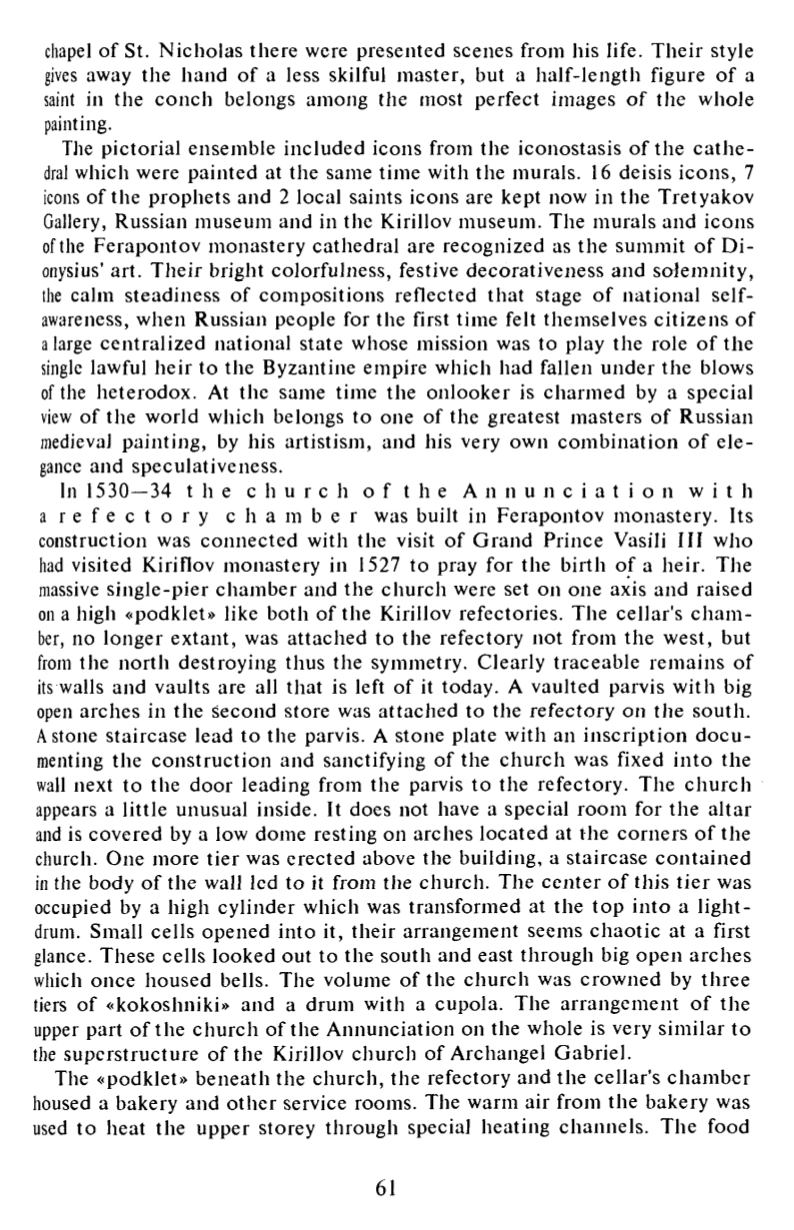

chapel of St. Nicholas there were presented scenes from his life. Their style
gives away the hand o f a less skilful master, but a half-length figure o f a
saint in the conch belongs among the most perfect images o f the whole
painting.
The pictorial ensemble included icons from the iconostasis o f the c a th e
dral which were painted at the same time with the murals. 16 deisis icons, 7
icons of the prophets and 2 local saints icons are kept now in the Tretyakov
Gallery, Russian museum and in the Kirillov museum. The murals and icons
of the Ferapontov monastery cathedral are recognized as the summit o f D i
onysius' art. Their bright colorfulness, festive decorativeness and solemnity,
the calm steadiness of compositions reflected that stage o f national self-
awareness, when Russian people for the first time felt themselves citizens of
a large centralized national state whose mission was to play the role o f the
single lawful heir to the Byzantine empire which had fallen under the blows
of the heterodox. At the same time the onlooker is charmed by a special
view of the world which belongs to one of the greatest masters of Russian
medieval painting, by his artistism, and his very own comb ina tion o f e le
gance and speculativeness.
In 1530—34 t h e c h u r c h o f t h e A n n u n c i a t i o n w i t h
a r e f e c t o r y c h a m b e r was built in Ferapontov monastery. Its
construction was connected with the visit o f Grand Prince Vasili III who
had visited Kiriflov monastery in 1527 to pray for the birth o f a heir. The
massive single-pier chamber and the church were set on one axis and raised
on a high «podklet» like both of the Kirillov refectories. The cellar's c h am
ber, no longer extant, was attached to the refectory not from the west, but
from the north destroying thus the symmetry. Clearly traceable remains of
its walls and vaults are all that is left of it today. A vaulted parvis with big
open arches in the second store was attached to the refectory on the south.
Astone staircase lead to the parvis. A stone plate with an inscrip tion do c u
menting the construction and sanctifying of the church was fixed in to the
wall next to the door leading from the parvis to the refectory. The chu rch
appears a little unusual inside. It does not have a special room for the altar
and is covered by a low dome resting on arches located at the corners o f the
church. One more tier was erected above the building, a staircase con ta ined
in the body o f the wall led to it from the church. The cen ter o f this tie r was
occupied by a high cylinder which was transformed at the top in to a light -
drum. Small cells opened into it, their arrangement seems chao tic at a first
glance. These cells looked out to the south and east through big open arches
which once housed bells. The volume of the church was crowned by three
tiers of «kokoshniki» and a drum with a cupola. The arrangement o f the
upper part o f the chu rch of the Annunciation on the whole is very similar to
the superstructure of the Kirillov church of Archangel Gabriel.
The «podklet» beneath the church, the refectory and the cellar's chambe r
housed a bakery and o ther service rooms. The warm air from the bakery was
used to heat the upper storey through special heating channels. The food
61















